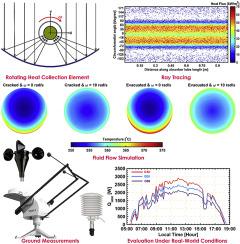Renewable Energy ( IF 9.0 ) Pub Date : 2021-09-16 , DOI: 10.1016/j.renene.2021.09.044 Hamza Amein 1 , Bassem M. Akoush 1 , M. Medhat El-Bakry 1 , Mohamed Abubakr 2 , Muhammed A. Hassan 1

|
The risk of vacuum loss in linear solar heat collection elements (HCEs) is one of the major practical challenges that are facing the parabolic trough solar concentrator (PTSC) systems in concentrating solar power (CSP) plants. Despite the long-life span of CSP systems, HCEs are frequently replaced due to permeated hydrogen (due to saturation of getters) or leaked air (due to failures in end metal-to-glass welding or cracked glass shells). This study proposes a low-tech solution for boosting the performance of PTSCs with partial or lost vacuum through rotating the HCEs. A carefully validated integrated 3D optical-thermal model is developed and used to quantify the energetic and exergetic performances of PTSCs with rotated and fixed HCEs for both cases of lost and maintained vacuum. Both steady and unsteady simulations are reported using high-precision ground measurements of direct irradiance and meteorological parameters. As the rotational speed increases from 0 to 20 rad/s, the energy efficiency of PTSCs with new and damaged HCEs is improved by ∼47 and 52%, respectively, at a Reynolds number of 4000 and an inlet temperature of 350 °C. By rotating a damaged HCE at only 10 rad/s, maximum improvements of ∼26 and 53% in the useful heat gain are obtained, compared to non-rotating evacuated and non-rotating damaged HCEs, respectively, at the same operating conditions. Overall, the advantage of the proposed concept is more pronounced when the PTSC is operating at relatively low flow rates, high temperatures, or under high irradiance levels.
中文翻译:

使用具有成本效益的旋转机制提高带有裂纹集热元件的抛物线槽式聚光器的能量利用
线性太阳能集热元件 (HCE) 中真空损失的风险是聚光太阳能 (CSP) 发电厂中抛物线槽式太阳能集中器 (PTSC) 系统面临的主要实际挑战之一。尽管 CSP 系统的使用寿命很长,但 HCE 经常会因氢渗透(由于吸气剂饱和)或空气泄漏(由于金属与玻璃的末端焊接失败或玻璃壳破裂)而被更换。这项研究提出了一种低技术解决方案,通过旋转 HCE 来提高部分真空或失去真空的 PTSC 的性能。开发了一个经过仔细验证的集成 3D 光热模型,用于量化具有旋转和固定 HCE 的 PTSCs 在失去真空和保持真空的情况下的能量和热能性能。使用直接辐照度和气象参数的高精度地面测量报告了稳态和非稳态模拟。随着转速从 0 增加到 20 rad/s,在雷诺数为 4000 和入口温度为 350 °C 时,具有新的和损坏的 HCE 的 PTSC 的能量效率分别提高了 47% 和 52%。在相同的操作条件下,通过仅以 10 rad/s 的速度旋转损坏的 HCE,与非旋转抽真空和非旋转损坏 HCE 相比,有效热增益分别提高了约 26% 和 53%。总体而言,当 PTSC 在相对较低的流速、高温或高辐照度水平下运行时,所提出概念的优势更为明显。随着转速从 0 增加到 20 rad/s,在雷诺数为 4000 和入口温度为 350 °C 时,具有新的和损坏的 HCE 的 PTSC 的能量效率分别提高了 47% 和 52%。在相同的操作条件下,通过仅以 10 rad/s 的速度旋转损坏的 HCE,与非旋转抽真空和非旋转损坏 HCE 相比,有效热增益分别提高了约 26% 和 53%。总体而言,当 PTSC 在相对较低的流速、高温或高辐照度水平下运行时,所提出概念的优势更为明显。随着转速从 0 增加到 20 rad/s,在雷诺数为 4000 和入口温度为 350 °C 时,具有新的和损坏的 HCE 的 PTSC 的能量效率分别提高了 47% 和 52%。在相同的操作条件下,通过仅以 10 rad/s 的速度旋转损坏的 HCE,与非旋转抽真空和非旋转损坏 HCE 相比,有效热增益分别提高了约 26% 和 53%。总体而言,当 PTSC 在相对较低的流速、高温或高辐照度水平下运行时,所提出概念的优势更为明显。在相同的操作条件下,通过仅以 10 rad/s 的速度旋转损坏的 HCE,与非旋转抽真空和非旋转损坏 HCE 相比,有效热增益分别提高了约 26% 和 53%。总体而言,当 PTSC 在相对较低的流速、高温或高辐照度水平下运行时,所提出概念的优势更为明显。在相同的操作条件下,通过仅以 10 rad/s 的速度旋转损坏的 HCE,与非旋转抽真空和非旋转损坏 HCE 相比,有效热增益分别提高了约 26% 和 53%。总体而言,当 PTSC 在相对较低的流速、高温或高辐照度水平下运行时,所提出概念的优势更为明显。











































 京公网安备 11010802027423号
京公网安备 11010802027423号